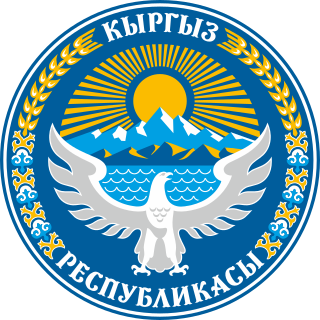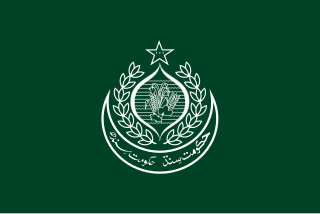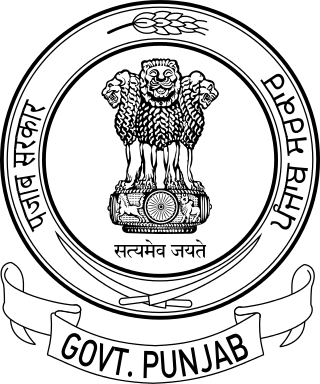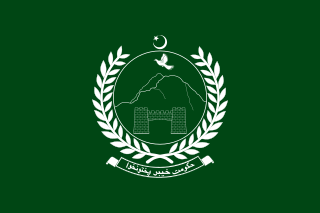
Punjab is a province of Pakistan. Located in central-eastern region of the country, Punjab is the second-largest province of Pakistan by land area and the largest by population. Lahore is the capital and the largest city of the province. Other major cities include Faisalabad, Rawalpindi, Gujranwala and Multan.

Punjabi, sometimes spelled Panjabi, is an Indo-Aryan language native to the Punjab region of Pakistan and India, spoken predominantly by the Punjabi people. With approximately 148 million native speakers, it is the eighth most spoken native language in the world. It also has a few million additional speakers which, along with native speakers, makes it the twelfth most spoken language by the total number of speakers in the world and third in South Asia.

The coat of arms of South Africa is the main heraldic insignia of South Africa. The present coat of arms was introduced on Freedom Day, 27 April 2000, and was designed by Iaan Bekker. It replaced the earlier national arms, which had been in use since 1910. The motto is written in the extinct ǀXam, member of the Khoisan languages, and translates literally to "diverse people unite". The previous motto, in Latin, was Ex Unitate Vires, translated as "From unity, strength".

The coat of arms of Manitoba is the heraldic symbol representing the Canadian province of Manitoba. The arms contains symbols reflecting Manitoba's British heritage along with local symbols. At the upper part of the shield is the red cross of St. George, representing England. On the left, the unicorn represents Scotland. The lower portion of the shield features a bison standing atop a rock on a green background, a symbol of First Nations peoples of the area who derived food and clothing from the animal.

The provincial flag of Saskatchewan was adopted in 1969. It is blazoned per fess vert and or, in the fly a prairie lily slipped and leaved proper, in the dexter chief an escutcheon of the coat of arms of Saskatchewan fimbriated argent. The symbolism within the flag is shown just with the colours; yellow representing the grain fields in the southern portion of the province where as the green represents the northern forested areas. The western red lily in the fly of the flag is the provincial flower. In 2017, The Minister of Parks, Culture and Sports designated September 22 as Saskatchewan Flag Day.

The national flag of Pakistan, also known as the Flag of the Star and Crescent, is made up of a green field with a stylized tilted white crescent moon and five-pointed star at its centre, and a vertical white stripe at its hoist-end. Though the specific shade of green on the flag is mandated only as 'dark green', its official and most consistent representation is in Pakistan green, which is shaded distinctively darker. It was adopted by the Constituent Assembly of Pakistan on 11 August 1947, and it became the official flag of the Dominion of Pakistan on 14 August 1947, following independence from the British Empire. The flag was subsequently retained as that of the Islamic Republic of Pakistan in 1956 and remains in use as the national flag to this day.

The Coat of Arms or State Emblem of Pakistan was adopted in 1954 and symbolizes Pakistan's ideological foundation, the basis of its economy, its cultural heritage and its guiding principles.

The flag of Yukon is a green, white, and blue tricolour with the coat of arms of Yukon at the centre above a wreath of fireweed, the territorial flower. An official flag for Yukon was created during the 1960s, a decade in which the national flag of Canada was chosen as well as several other provincial flags were created. The flag of Yukon was officially selected from a territory-wide design competition in 1967, with the winning design adopted on March 1, 1968.

Regional tartans of Canada are represented by all Canada's provinces and territories having a regional tartan, as do many other regional divisions in Canada. Tartans were first brought to Canada by Scottish settlers; the first province to adopt one officially was Nova Scotia in 1956, and the most recent province was Ontario, in 2000. Except for the tartan of Quebec, all of the provincial and territorial tartans are officially recognized and registered in the books of the Court of the Lord Lyon, King of Arms of Scotland.

The National emblem of Kyrgyzstan was adopted in 2016. The emblem has a circular form which mostly bears the color blue. Light blue is known as the Kyrgyz color of courage and generosity. To the left and right of the coat of arms, wheat and cotton are displayed. In the upper part, the name of the country appears in Kyrgyz "Кыргыз Республикасы". It was designed by A. Abdraev and S. Dubanaev.

The state emblem of Uzbekistan was formally adopted on July 2, 1992, by the newly establish Republic of Uzbekistan. It bears many similarities to the emblem of the previous Uzbek Soviet Socialist Republic (SSR), which Republic of Uzbekistan succeeded. Like other post-Soviet republics whose symbols do not predate the October Revolution, the current emblem retains some components of the Soviet one. Prior to 1992, Uzbekistan had an emblem similar to all other Soviet Republics, with standard communist emblems and insignia.

The Government of Punjab is the provincial government of the Pakistani province of Punjab. It is based in Lahore, the provincial capital. Its powers and structure are set out in the provisions of the Constitution, in which 41 districts come under its authority and jurisdiction. The government includes the cabinet, selected from members the Punjab Provincial Assembly, and the non-political civil staff within each department. The province is governed by a unicameral legislature with the head of government known as the Chief Minister. The Chief Minister, invariably the leader of a political party represented in the Assembly, selects members of the Cabinet. The Chief Minister and Cabinet are thus responsible for the functioning of government and are entitled to remain in office so long as it maintains the confidence of the elected Assembly. The head of the province is known as the Governor, appointed by the federal government, on behalf of the President, while the administrative boss of the province is Chief Secretary Punjab.
Pakistan has several official national symbols, including a flag, an emblem, an anthem, a memorial tower as well as several national heroes. The symbols were adopted at various stages in the existence of Pakistan and there are various rules and regulations governing their definition or use. The oldest symbol is the Lahore Resolution, adopted by the All India Muslim League on 23 March 1940, and which presented the official demand for the creation of a separate country for the Muslims of India. The Minar-e-Pakistan memorial tower which was built in 1968 on the site where the Lahore Resolution was passed. The national flag was adopted just before independence was achieved on 14 August 1947. The national anthem and the state emblem were each adopted in 1954. There are also several other symbols including the national animal, bird, flower and tree.

The State Emblem of the Tajik Soviet Socialist Republic was adopted on March 1, 1937 by the government of the Tajik Soviet Socialist Republic. The emblem is based on the State Emblem of the Soviet Union. It shows symbols of agriculture. The red star is prominently featured with a small hammer and sickle within it. The rising sun stands for the future of the Tajik nation, and the star as well as the hammer and sickle for the victory of communism and the "world-wide socialist community of states". The emblem was replaced with the new emblem in 1992, which uses a similar design to the Soviet one. It was, however, was replacing the red banner with the current national flag, the big red star was replaced by the mountains, represents Pamir, the Samanid dynasty crown, and added the Quran book at below. It represents Islam as the official religion.

The coat of arms of Kropyvnytskyi is one of the city's symbols reflecting its past and the controversies of its history.

Jhawarian is a town located near the Jhelum River in the District Sargodha, Tehsil Shahpur, Punjab, Pakistan.

The flag of Sindh is the official flag of the Pakistani province of Sindh. It uses the same colours as the national flag of Pakistan, dark green and white. The emblem of the province representing its major crops forms the centre of the flag with "Government of Sindh" written in Sindhi and Urdu on a crescent. It was adopted in 2005, by the Provincial Assembly of Sindh.

The Emblem of Punjab is the official state emblem of the Indian state of Punjab and it is used as the official symbol of the Government of Punjab.

The Flag of Khyber Pakhtunkhwa is the flag of the Province of Khyber Pakhtunkhwa within Pakistan. The KPK provincial flag shows Jamrud Fort, the guardian of the Khyber Pass and mountains in the back. Displaying Pakistani national colours, white and dark Green, with a small Crescent and star at the top to represent the Muslim-majority all of which shows its Islamic heritage and strong ties with the Federation of Pakistan, and the Inscription below in a scroll reads the official name of the province in Urdu, respectively.

The flag of Gilgit–Baltistan is the flag of the Autonomous Province of Gilgit Baltistan within "Northern Pakistan". The Gilgit Baltistan provincial flag shows the emblem of Pakistan is reflective of the natural topography of the province - the Markhor, is the "National animal"; Deodar cedar, is the "National tree"; and K2 is the "National mountain" of the country. Displaying Pakistani national colours, white and dark Green, with a Crescent and star to represent the Muslim-majority all of which shows its Islamic heritage and strong ties with the Federation of Pakistan respectively. No Inscription devised below in Urdu, respectively.




















